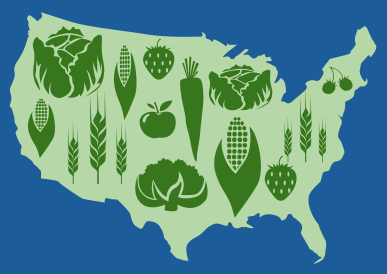In elementary school, our teacher always told us, “You will need to know this” or “This will be useful later.” We worked through abstract lessons in biology and multiplication tables, sometimes questioning the connection it had to our lives. There is never that question when it comes to food. Our eating choices affect how we feel, act and think. Yet, for a long time we have not provided kids with essential knowledge about where our food comes from or why we eat what we eat. One of the most important life skills is choosing and preparing foods that are good for you. Kids love eating, playing, and being outside; so let us take advantage of their energy and teach them about food.
Many schools are beginning to integrate local food into school meals in order to support nearby farmers and improve the health of students. A healthy meal is essential for a productive day of school and most of us are familiar with the mystery meat served with soggy vegetables and sugary sides that have graced the plates of many school meals. Now, farm to school programs have been started in approximately 38,629 schools nationwide and many schools have committed to providing fresh, delicious meals for students (USDA). Schools use clever terms like “crunch lunch” for salad bars and “grab apples” for sliced apples. Creative new options have been proven to improve kids’ food choices at home and the amount of fruits and vegetable servings (Elsener, Eschmeyer, & Davidson, n.d.).
Farm to school lunch programs open up a multimillion-dollar market to family farmers. In 2011-2012, schools farm to school initiatives bought $350 million in local food and more than 50% of those schools planned to use more in the future (USDA).
Farm to school can often be supplemented with curriculum that covers nutrition, cooking, and ecological lessons about food. Starting a school edible garden is one of the best ways to integrate the food curriculum and bring the school to the farm. Kids love to get dirty and be active, so why don’t we put them to work in a garden? This interaction with the origins of food provides sustainable, positive change to food habits. Students start to prefer fruits and vegetables and they gain a full understanding and positive attitude toward the school lunch program, their food choices, seasonal produce, and the ecological impact of food systems (Turpin, 2010). Of course these gardens require lots of time, funding, and hard work (Turpin, 2010). School districts must be dedicated to the cause. However, it is possible to use a variety of resources from farmers and food organizations. Lessons in food and eating are more crucial than ever to support healthy, productive, and happy students.
Elsener, M., Eschmeyer, D., & Davidson, S. (n.d.). Nourishing the nation one tray at a time: Farm to school initiatives in the child nutrition reauthorization. National Farm to School Network. Retrieved from: http://www.farmtoschool.org/files/publications_192.pdf
“Farm to School.” USDA Food and Nutrition Service. Retrieved from: http://www.fns.usda.gov/farmtoschool/farm-school
Turpin, A. (2010). Study on school gardens brings fresh results. Civil Eats. Retrieved from: http://civileats.com/2010/10/01/study-on-school-gardens-brings-fresh-results/

